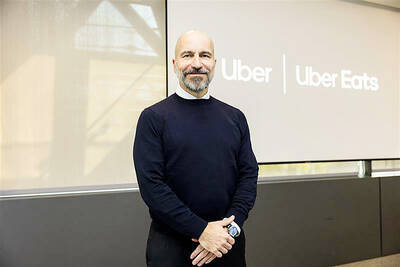A decade after the guardians of the world economy united to save it from depression, the scope for such shock-and-awe policies has all but dried up.
It was 10 years ago today that the US Federal Reserve and five fellow central banks banded together for a rare coordinated interest rate cut. They went on to deploy massive monetary stimulus as the global economy spiraled lower.
As global finance chiefs prepare to meet this week in Bali, Indonesia, for the annual IMF and World Bank meetings, they do so without the firepower of 2008 and with the era of coordination looking like an anomaly.

Photo: EPA
Today, central banks still have historically low interest rates and are following different paths, while finance ministers are hamstrung by debt. Governments are also pushing nationalist, not globalist, agendas and grappling with headaches such as Brexit, trade wars, surging oil prices and volatile currencies.
“There are no arrows left in the economic quiver,” said Danny Blanchflower, a professor at Dartmouth College in New Hampshire who was a policymaker at the Bank of England in 2008. “Imagine it’s only as half a big a downturn next time; there’s still much fewer weapons to protect us.”
It was the US central bank, under former Fed chairman Ben Bernanke, which took the lead in bringing the world’s monetary policymakers together to cut rates on Oct. 8, 2008.
Counterparts in the euro area, Canada, the UK, Sweden and Switzerland also acted, while the Bank of Japan, which already had ultra-low rates, voiced support. The People’s Bank of China also eased borrowing costs and bank reserve requirements, although it did not tie its moves to those of the US-led coalition.
All told, Bank of America Corp calculates that global central banks cut interest rates about 700 times and bought US$12 trillion of financial assets since September 2008’s collapse of Lehman Brothers Holdings Inc. Global government debt surged about 75 percent to US$67 trillion.
It is hard to see such forceful and combined action happening today.
For one thing, monetary policy lacks the scope it had. Even though the Fed is tightening policy, the average rate of developed countries only just passed 1 percent and should still be below its pre-crisis level a year from now, JPMorgan Chase & Co said.
The Fed’s balance sheet alone is still about 20 percent of GDP.
Furthermore, the Fed and the European Central Bank are among those who faced political criticism for the actions. That might curb room for uniting across borders next time, PGIM Fixed Income chief economist Nathan Sheets said.
Sheets was director of the Fed’s international finance division 10 years ago.
“Maybe there would be more political scrutiny as to why are you allowing some other country to dictate your monetary policy,” he said.
The political obstacles might prove particularly daunting when it comes to the Fed activating emergency swap lines to provide other central banks with US dollars to dole out in a crisis. Those lines — in which the Fed swapped US dollars for foreign currency — proved crucial in easing global liquidity strains a decade ago but were subsequently attacked by some Republican lawmakers as handouts to foreign banks.
“The Federal Reserve was the central bank of the world,” said former Fed official Edwin Truman, who is now a senior fellow at the Peterson Institute for International Economics in Washington.
He said the Fed would not provide such levels of support today with the more nationalistic Donald Trump as US president.
Fear of the future is one reason why some such as Blanchflower advise central banks to be wary of raising rates now. It would be better to guarantee an expansion is sustainable before pushing up rates, their argument goes.
Central bankers might still have to be more inventive next time around, embracing negative rates more wholeheartedly or mimicking Bank of Japan-style efforts to control bond yields. Joachim Fels, global economic adviser at Pacific Investment Management Co in Newport Beach, California, sees the chance for “direct financing of fiscal stimulus (aka people’s QE).”
"Ideally policymakers will broaden their toolkits to fight the next crisis," said Cui Li, head of macro research at CCB International Holdings Ltd. in Hong Kong. "But a coherent strategy doesn’t seem to be in sight."

CHIP RACE: Three years of overbroad export controls drove foreign competitors to pursue their own AI chips, and ‘cost US taxpayers billions of dollars,’ Nvidia said China has figured out the US strategy for allowing it to buy Nvidia Corp’s H200s and is rejecting the artificial intelligence (AI) chip in favor of domestically developed semiconductors, White House AI adviser David Sacks said, citing news reports. US President Donald Trump on Monday said that he would allow shipments of Nvidia’s H200 chips to China, part of an administration effort backed by Sacks to challenge Chinese tech champions such as Huawei Technologies Co (華為) by bringing US competition to their home market. On Friday, Sacks signaled that he was uncertain about whether that approach would work. “They’re rejecting our chips,” Sacks

NATIONAL SECURITY: Intel’s testing of ACM tools despite US government control ‘highlights egregious gaps in US technology protection policies,’ a former official said Chipmaker Intel Corp has tested chipmaking tools this year from a toolmaker with deep roots in China and two overseas units that were targeted by US sanctions, according to two sources with direct knowledge of the matter. Intel, which fended off calls for its CEO’s resignation from US President Donald Trump in August over his alleged ties to China, got the tools from ACM Research Inc, a Fremont, California-based producer of chipmaking equipment. Two of ACM’s units, based in Shanghai and South Korea, were among a number of firms barred last year from receiving US technology over claims they have

It is challenging to build infrastructure in much of Europe. Constrained budgets and polarized politics tend to undermine long-term projects, forcing officials to react to emergencies rather than plan for the future. Not in Austria. Today, the country is to officially open its Koralmbahn tunnel, the 5.9 billion euro (US$6.9 billion) centerpiece of a groundbreaking new railway that will eventually run from Poland’s Baltic coast to the Adriatic Sea, transforming travel within Austria and positioning the Alpine nation at the forefront of logistics in Europe. “It is Austria’s biggest socio-economic experiment in over a century,” said Eric Kirschner, an economist at Graz-based Joanneum

OPTION: Uber said it could provide higher pay for batch trips, if incentives for batching is not removed entirely, as the latter would force it to pass on the costs to consumers Uber Technologies Inc yesterday warned that proposed restrictions on batching orders and minimum wages could prompt a NT$20 delivery fee increase in Taiwan, as lower efficiency would drive up costs. Uber CEO Dara Khosrowshahi made the remarks yesterday during his visit to Taiwan. He is on a multileg trip to the region, which includes stops in South Korea and Japan. His visit coincided the release last month of the Ministry of Labor’s draft bill on the delivery sector, which aims to safeguard delivery workers’ rights and improve their welfare. The ministry set the minimum pay for local food delivery drivers at